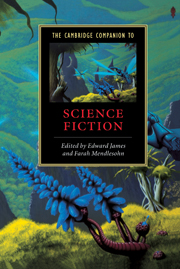Book contents
- Frontmatter
- Introduction
- Part 1 The history
- 1 Science fiction before the genre
- 2 The magazine era: 1926–1960
- 3 New Wave and backwash: 1960–1980
- 4 Science fiction from 1980 to the present
- 5 Film and television
- 6 Science fiction and its editors
- Part 2 Critical approaches
- Part 3 Sub-genres and themes
- Further Reading
- Index
- Series List
5 - Film and television
from Part 1 - The history
Published online by Cambridge University Press: 28 May 2006
- Frontmatter
- Introduction
- Part 1 The history
- 1 Science fiction before the genre
- 2 The magazine era: 1926–1960
- 3 New Wave and backwash: 1960–1980
- 4 Science fiction from 1980 to the present
- 5 Film and television
- 6 Science fiction and its editors
- Part 2 Critical approaches
- Part 3 Sub-genres and themes
- Further Reading
- Index
- Series List
Summary
Science fiction film: the first fifty years
In the first book of film theory, written in 1915, Vachel Lindsay imagined a modern America transformed into a permanent World's Fair. Central to his poetic vision of the coming technocracy was the cinema, whose 'prophetwizards will set before the world a new group of pictures of the future' surpassing even Jules Verne, Edward Bellamy and H. G. Wells. Lindsay's peculiar rhetoric has obvious resonances with the interplay of entertainment, education and prophecy in Gernsback's model of scientifiction, but as the manifesto for a new kind of cinema it found few, if any, adherents - not least because sf cinema had been developing in a different direction since the Lumière brothers' Charcuterie méchanique (The Mechanical Butcher, 1895). A one-minute, single-scene short, it showed a pig being fed into a machine from which various cuts of pork soon emerge. Audiences might well have also seen the film projected in reverse, and one of its imitators, Dog Factory (Porter, 1904), utilized this basic technique to depict a machine that reconstituted strings of sausages into whatever breed of dog the customer required.
- Type
- Chapter
- Information
- The Cambridge Companion to Science Fiction , pp. 79 - 95Publisher: Cambridge University PressPrint publication year: 2003
- 6
- Cited by



